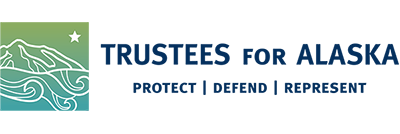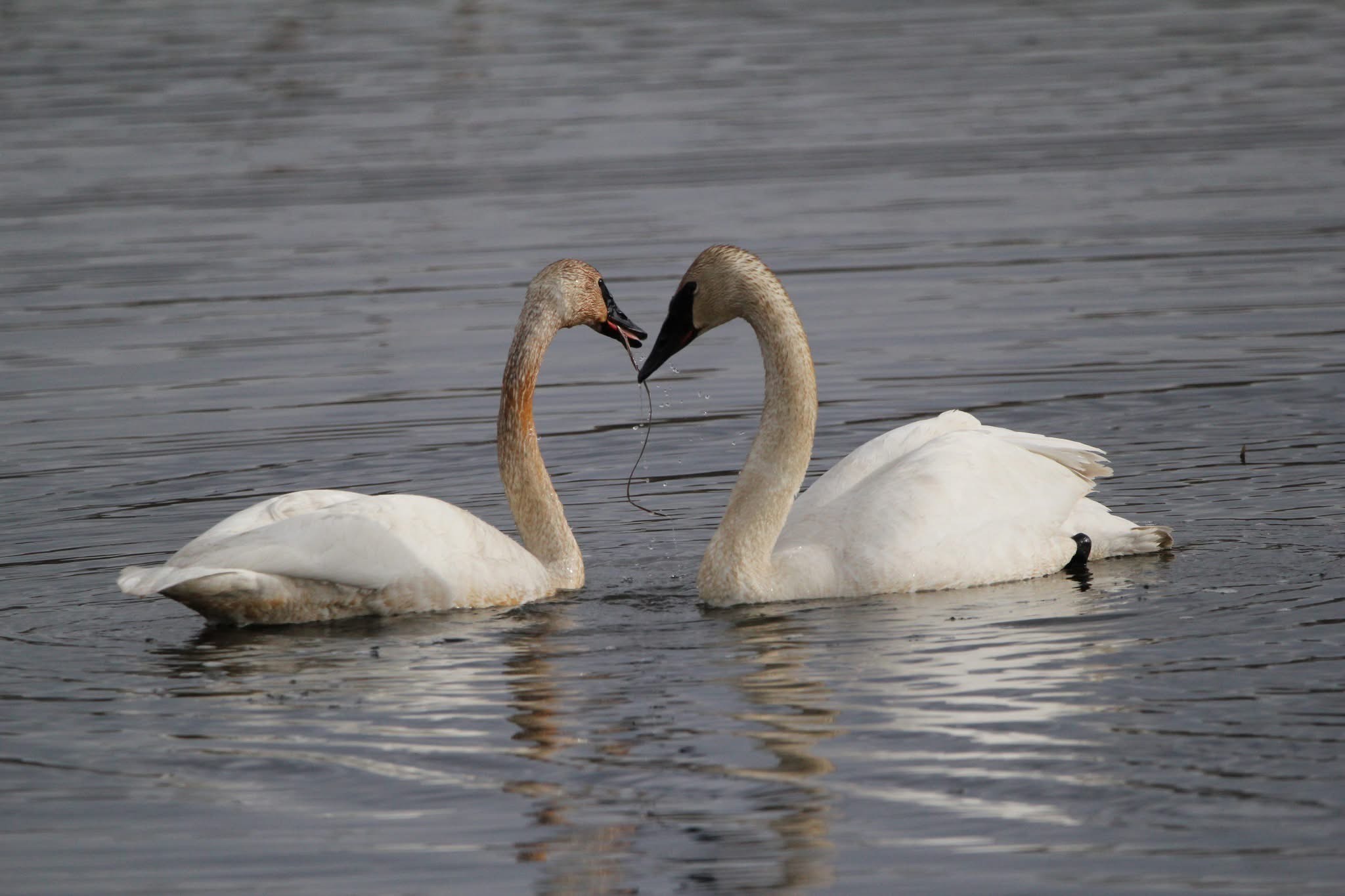
Showing Alaska our love—the places, beings, and experiences that fill our hearts
In Alaska, February brings more hours of sunlight after months of long nights. Even when it’s cold it feels brighter. It’s the month of love, after all, so we asked staff to share small stories about the places, beings, and/or experiences in nature that fills their hearts.
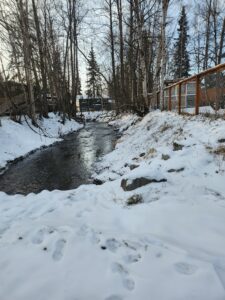
South fork of Chester Creek. Photo by Bridget Psarianos.
Water runs through it
Bridget Psarianos, senior staff attorney,
I love Chester Creek because it’s a constant reminder to me of the urban/wild interface that makes Anchorage so special. The south fork of Chester Creek runs through our yard (pictured) and people might not know it flows all the way from the mountains to Cook Inlet. We get to see and hear salmon swimming upstream every year from our deck, and have lots of ducks, moose, and sometimes bears stop by. I show it love by picking up bits of litter that get dropped nearby and carrying on my losing battle with the invasive plants that like to grow along the creek bed.

Caribou on the hillside in Lake Clark National Park. Photo by Brook Brisson.
Caribou love
I love caribou! I love watching them, I love listening to them, I love following their trails through the alpine tundra, and I love thinking about them moving through the landscape. Finding a shed feels magical and I can’t help but kick their piles of poop to see how recently they were there.
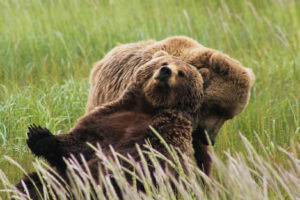
Brown bear cuddles in Lake Clark National Park. Photo by Madison Grosvenor.
Bear hugs all around (metaphorically)
Madison Grosvenor, communications Specialist
Alaska’s bears have always had my heart. Last year, I finally checked a big one off my bucket list—a bear tour in Lake Clark National Park. As our float plane touched down on the beach, I looked out to see dozens of brown bears scattered across the field, their fuzzy backs hunched over as they grazed. It was a sight I’ll never forget.
People tend to think of bears as fierce apex predators, but what stuck with me most wasn’t their power, it was their social lives. They pick up on the smallest shifts in body language, communicate with short vocalizations, and even have an incredible sense of play. We watched bears move out of each other’s way with a short huff and roll around together in the sedges. In places with little human interference and plenty of food, they can coexist in a way that can only be described as peace. Watching that unfold in front of my own eyes was something special.
That trip only deepened my love for these incredible animals. I continue to show them love by keeping my distance, learning as much as I can (about them and from them), and sharing their importance with anyone who will listen. The best way to love bears? Respect their space, support efforts to protect them, and never stop learning about the wild places they call home.

Ashley and friends crossing a snow patch with Pinnell Mountain in the background. Photo taken by Hannah Gerrish.
The in-between places
Ashley Donovan, legal fellow
A place that I love is the White Mountains National Recreation Area in Interior Alaska. The mountain ridges of the Pinnell Trail overlook expansive views of the Yukon Flats National Wildlife Refuge. Each year, the Fortymile caribou herd migrates over Eagle Summit on their way to the Yukon in Canada. While I haven’t seen caribou there myself, I have hiked the Trail twice and seen signs, including shed velvet and a yearling calf’s first set of antlers. This herd declined to just 4,000 members in the 1970s, but now numbers about 40,000. This place reminds me of the importance of preserving public lands for the protection of wildlife, especially the in-between spaces that ensure the cycle of life continues.
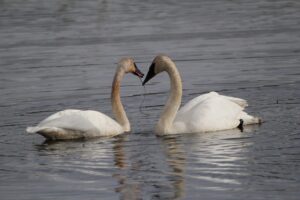
A pair of swans at Potters Marsh. Photo by Tracy Lohman.
Bird chirps and fly-bys
Tracy Lohman, development director
All the birds. From the backyard to the rare sightings of migratory species. They connect me to the natural world. Birds are an indicator of the health and well-being of our shared air, water and land. Essentials for all living things. Take time to enjoy their chirps in the woods, or the quick fly-by and get outside.
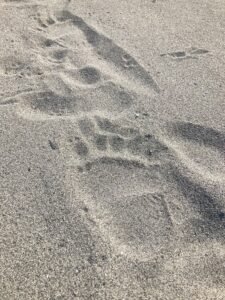
Bear, wolf, and human prints in Glacier Bay National Park. Photo by Dawnell Smith.
Love notes
Dawnell Smith, communications director
I love seeing animal leavings scattered along ridges, valleys, riversides, and trails—antlers, wolf prints in mud, bear tracks in sand, abandoned bird nests, the course strands of hair found in pancaked grasses where moose once rested.
Lemming bones and owl pellets. The patterns of snowshoe hare tracks across fresh snow.
So much of what I see of animals shows up in the sign of their having passed the same way. What they leave behind can feel like warnings at times, just as signs of my presence might cause others to stop in their tracks or alter course. A warm pile of bear scat might prompt me to change routes, for example, and definitely lifts the hair on my neck.
But mostly, these signs remind me that though I may feel I’m alone, I’m not. There’s a whole community moving though and sharing pathways. You might say that the things beings leave behind are like love notes—an expression of an essential kind of belonging.
I believe that when we stand up for natural spaces and every being who moves through them, we stand up for where we all belong.
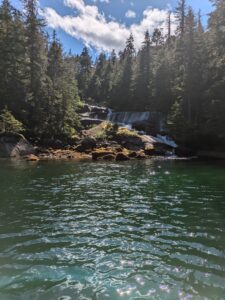
Hidden Bay in Prince William Sound. Photo by Joanna Cahoon.
Hidden beauty
Joanna Cahoon, staff attorney
I’m going with Hidden Bay in Prince William Sound. I love the little narrow entrance and there are some beautiful lakes to hike to that are great for swimming.
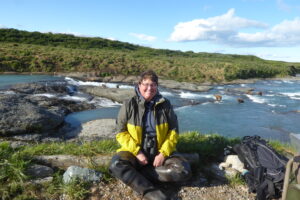
Vicki at Mcniel River Bear Sanctuary in 2020. Photo courtesy of Vicki Clark.
A sanctuary
Vicki Clark, executive director
I love the McNeil River State Game Sanctuary, which is just north of Katmai National Park and Preserve. The 200-square-mile sanctuary is an amazing place where the largest concentration of brown bears in the world can just be bears.
There is a bear-viewing program at McNeil that comprises a lottery each year for 4-day permits. No more than 10 people a day who win the permits hike out with an Alaska Department of Fish and Game naturalist to various sites where the bears are doing life activities of feeding, playing, fighting, mating, and rearing young. This program has been going on for decades and it is a magical experience to sit with the bears for hours.
The bears are quite used to humans and go about their daily lives feeling no threat, which means you may see cubs nursing and subadults playing at very close range.
I have been to McNeil twice and every day is a new adventure. I highly recommend getting out there for a visit.
While this sanctuary exists, there are external threats that arise. One is the proposed Pebble mine, which would be nearby, as well as hunting activities that the Department of Fish and Game authorizes in its efforts to cull predators of moose and caribou. To help protect the area, groups like the Alaska Wildlife Alliance, Friends of McNeil River, or McNeil River Alliance are good organizations to follow and support. For the brown bears.
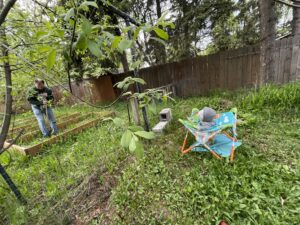
Garden cleanup with family! Photo by Ashley Boyd.
It’s about community
Ashley Boyd, administrative director
I really appreciate the abundant and accessible communal outdoor space in Anchorage. I try to pick up trash and contribute to upkeep of dog parks, playgrounds, and trails. I hope to expand how I help out by taking my kid to the city-wide cleanup each year, so he learns the importance of contributing positively to these community spaces.

Megan enjoying a sunset off the coastal trail. Photo credit: Joseph Ren
Greenway commutes
Megan Mason Dister, legal fellow
I love Anchorage’s greenways. I’m lucky to live near the Chester Creek and the Coastal trails, and I spend time on them almost every day. In such a car-centric city these trails allow me to walk or bike commute throughout the year. Just when I become accustomed to the daily routine of a morning commute, I often see a beautiful sunrise and I’m so grateful for where I live and the parks in our city.
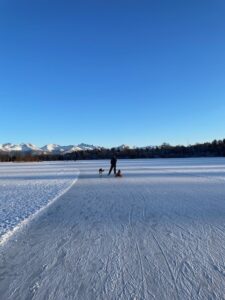
Skating on the lagoon. Photo by Siobhan McIntyre.
Natural ice and warming barrels
Siobhan McIntyre, staff attorney
I love skating on Anchorage’s lakes and ponds, covered in natural ice from December through March! The Anchorage Municipality and the Anchorage community works together to show the love by keeping the ice cleared and provisioned with warming barrels and picnic tables. We can show the love by throwing away our cocoa cups, snack wrappers, and other ice party trash!


